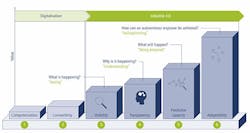As a global supplier of polymer products with $3.7 billion in annual sales, 120 facilities in 47 countries and 23,000 employees, Trelleborg Group is the type of company one might expect to be well along its journey toward realizing any number of smart manufacturing, Industrie 4.0 or Industrial Internet of Things (IIoT) projects. The reality is that Trelleborg, like most companies, is just starting the process in earnest.
At the MESA 2018 North America conference in Raleigh, N.C., Tomas Norbut, Trelleborg’s IIoT program manager and IT infrastructure project manager, said Trelleborg has had numerous advanced manufacturing projects ongoing at its various sites, but—up until recently—there was “no cohesiveness” among these projects due to the company’s decentralized operating processes.
An Industrie 4.0 process illustration from Aachen University (see image above) provided Norbut with a framework for understanding Industrie 4.0 and the components and processes involved. It also helped him assess where Trelleborg was really at in terms of its digital manufacturing progress. Sharing this illustration with several of Trelleborg’s operations personnel, “they all thought they were very advanced—around stage 5 or 6,” said Norbut. “But they were really only in the early digitalization phase—stages 1 or 2.”
From this starting point, Norbut had all of Trelleborg’s sites complete an online survey to determine what capabilities the company actually had in place at its facilities. Through this survey, Norbut learned that only about 14 percent of the company’s machines were connected to a network and 83 percent of key data points were still being collected manually. Speaking about the company’s data collection methods, Norbut said it’s not uncommon to have clipboards attached to machines for manual recording of data that’s processed by hand for things like overall equipment effectiveness (OEE) analysis at the end of a shift. Norbut also learned that 57 percent of Trelleborg’s sites do have MES-ready machines in operation and that 61 percent of the company’s sites have fewer than 100 employees. This last fact revealed for him that Trelleborg is essentially operating a “bunch of small businesses,” he said.
Because of Trelleborg’s decentralized operations, Norbut noted “we don't have a common stack for anything” when asked what software packages Trelleborg is using to drive its Industrie 4.0 projects. In fact, the company has 60 different ERP packages installed across its sites, he said. Given this situation, Norbut does not envision ever having a central technology stack in place for all of the company’s sites, but he does foresee the implementation of common technology structures.
Armed with these insights into the company’s operating realities, Norbut has now begun the process of establishing road maps to help sites achieve specific capability levels, establish a common vocabulary around the company’s technology initiatives, develop education around these technologies and associated projects, and evaluate high-performer best practices. The good news, said Norbut, is that “Everyone at Trelleborg is hungry to go after smart manufacturing. They understand the benefits.”
Even though Trelleborg is still in the early phases of its journey toward IIoT, Norbut pointed out one particularly valuable lesson he has already learned. “When you're looking for trusted partners to help you on your IIoT journey, realize that it likely won't be someone you already know or have heard of. A lot of large-scale organizations that you think have a lot of experience in this, don’t. Look at what they’ve done, not just what they say; ask if you can visit their customers to see what they've really done.”
Norbut said the reason for this disconnect in expectations is that smart manufacturing technology is just now becoming widely available. “No one is as far behind as they think they are; everyone’s just getting started,” he said.
He did caution, however, to not take the lack of IIoT advancement by many companies as a reason to not be actively moving forward now. Even though most everyone is just getting started on this, “If you aren’t actively planning around this now, you will be left behind.”

